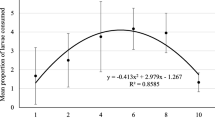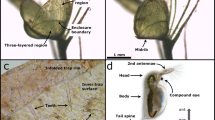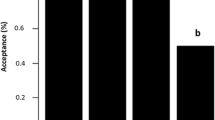Abstract
Various aspects of the ability of the predacious miteAmblyseius bibens Blommers to survive under conditions of prey scarcity were studied in the laboratory.
The presence of water considerably lengthened survival in the absence of food. An ability to pierce leaves was not observed in the predator. Walking speed was little affected by hunger, but declined with inanition. Activity (=percentage time spent walking) was greatest in well fed females, and decreased with increasing hunger, and eventually with inanition. Hence, the area searched per unit time decreased with increasing hunger and inanition. Hungry predators showed greater activity on more hairy leaves. Hungry predators became more restive in the presence of a cover. A webbed area was preferred (as resting place) by the predator, whether hungry or not. Gut content, and hence initial feeding, was only representative for the state of hunger, if the availibility of water was accounted for. Duration of the complete recovery (oviposition) in the presence of ample food provided a measure of the original inanition. Many kinds of pollen might serve as alternate food.
Résumé
Divers aspects de la capacité de l'acarien prédateurAmblyseius bibens Blommers à survivre dans des conditions de rareté des proies ont été étudiés au laboratoire.
La présence d'eau augmente considérablement la survie en l'absence de nourriture. On n'a pas observé de faculté de percer les feuilles chez ce prédateur. La vitesse de déplacement est peu affectée par la faim mais diminue avec le jeûne.
L'activité (=pourcentage de temps consacré aux déplacements) est plus grande chez les femelles bien nourries, elle décroît avec l'augmentation de la faim et éventuellement avec l'inanition. Aussi, la surface explorée par unité de temps décroît lorsque la faim et le jeûne augmentent. Les prédateurs affamés ont une plus grande activité sur les feuilles plus poilues, ils deviennent plus tranquilles en présence d'un couvert. Une surface membraneuse est préférée comme lieu de repos par le prédateur qu'il soit affamé ou non. Le contenu de l'intestin et par suite le premier repas, est le seul indice de l'état de famine si la nourniture en eau est assurée. La durée de la récupération totale marquée par la ponte en présence d'une alimentation abondante donne une mesure du jeûne subi. Beaucoup d'espèces de pollen peuvent être utilisées comme aliment de remplacement.
Similar content being viewed by others
References
Blommers, L.—1976. Capacities for increase and predation inAmblyseius bibens [Acarina: Phytoseiidae]. —Z. Angew. Entomol. (in press).
Blommers, L. &Van Etten, J.—1975.Amblyseius bibens [Acarina: Phytoseiidae], a predator of spider mites [Tetranychidae] in Madagascar.—Entomol. Exp. Appl., 18, 329–336.
Chant, D.A.—1959. Phytoseiid mites [Acarina: Phytoseiidae]. Part I. Bionomics of seven species of Southeastern England.—Can. Entomol., 91 (suppl. 12), 1–44.
——1961. The effect of prey density on prey consumption and oviposition in adults ofTyphlodromus (T) occidentalis Nesbitt [Acarina: Phytoseiidae] in the laboratory.—Can. J. Zool., 39, 311–315.
Elsey, K.D.—1974. Influence of host plant on searching speed of two predators.—Entomophaga, 19, 2–6.
Fischer, R.A. &Yates, R.—1963. Statistical Tables for Biological, Agricultural and Medical Research (6th ed.).—Oliver & Boyd, London.
Fransz, H.G.—1974. The Functional Response to Prey Density in an Acarine System—PUDOC, Wageningen, Holland.
Holling, C.S.—1966. The functional response of invertebrate predators to prey density.—Mem. Entomol. Soc. Can., 48, 1–86.
Huffaker, C.B.—1958. Experimental studies on predation: dispersion factors and predators-prey oscillations.—Hilgardia, 27, 343–383.
Huffaker, C.B., Van se Vrie, M. &McMurtry, J.A.—1969. The ecology of tetranychid mites and their natural control.—Annu. Rev. Entomol., 14, 125–174.
Hussey, N.W. &Bravenboer, L.—1971. Control of pests in glasshouse culture by the introduction of natural enemies. In: Biological Control. (C.B. Huffaker ed.).—Plenum Press, New York, 195–216.
Hussey, N.W. & Huffaker, C.B.—1975. Spider mites. In: Studies in Biological Control (V.L. Delucchi ed.).—Cambridge Univ. Press, 179–228.
Laing, J.E. &Huffaker, C.B.—1969. Comparative studies of predation byPhytoseiulus persimilis Athias-Henriot andMetaseiulus occidentalis (Nesbitt) [Acarina: Phytoseiidae] on populations ofTetranychus urticae Koch, [Acarina: Tetranychidae].—Res. Popul. Ecol., 11, 105–126.
Laing, J.E. &Osborn, J.A.L.—1974. The effect of prey density on the functional and numerical responses of three species of predatory mites.—Entomophaga, 19, 267–277.
Mori, H.—1969. The influence of prey density on the predation ofAmblyseius longispinosus (Evans)[Acari: Phytoseiidae].—Proc. 2nd Intern. Congr. Acarol. (1967), 149–153.
Mori, H. &Chant, D.A.—1966a. The influence of prey density, relative humidity and starvation on the predacious behavior ofPhytoseiulus persimilis Athias-Henriot [Acarina: Phytoseiidae].—Can. J. Zool., 44, 483–491.
——1966b. The influence of humidity on the activity ofPhytoseiulus persimilis Athias-Henriot and its preyTetranychus urticae (C. L. Koch) [Acarina: Phytoseiidae, Tetranychidae].—Can J. Zool., 44, 863–871.
Putman, W.L.—1962. Life history and behavior of the predacious miteTyphlodromus (T.) caudiglans Schuster [Acarina: Phytoseiidae] in Ontario, with notes on the prey of related species.—Can. Entomol., 94, 163–177.
Putman, W.L. &Herne, D.C.—1964. Relations betweenTyphlodromus caudiglans Schuster [Acarina: Phytoseiidae] and phytophagous mites in Ontario peach orchards.—Can. Entomol., 96, 925–943.
Rasmy, A.H. &Elbanhawy, E.M.—1974. Behaviour and bionomics of the predatory mitePhytoseius plumifer [Acarina: Phytoseiidae] as affected by physical surface features of host plants.—Entomophaga, 19, 255–257.
Sandness, J.N.—1969. Functional response ofPhytoseiidae [Acari] to increased prey density.—Ph. D. Thesis, Univ. California, Riverside.
Sandness, J.N. &McMurtry, J.A.—1970. Functional response of three species ofPhytoseiidae [Acarina] to prey density.—Can. Entomol., 102, 692–704.
——1972. Prey consumption behavior ofAmblyseius largoensis in relation to hunger.—Can. Entomol., 140, 461–470.
Santos, M.A.—1975. Functional and numerical responses of the predatory mite,Amblyseius fallacis, to prey density.—Environ. Entomol., 4, 989–992.
Swirski, E., Amitai, S. &Dorzia, N.—1967. Laboratory studies on the feeding, development and reproduction of the predacious mitesAmblyseius rubini Swirski & Amitai andAmblyseius swirskii Athias [Acarina: Phytoseiidae] on various kinds of food substances.—Israel J. Agric. Res., 17, 101–119.
Author information
Authors and Affiliations
Rights and permissions
About this article
Cite this article
Blommers, L., Lobbes, P., Vink, P. et al. Studies on the response ofAmblyseius bibens [Acarina: Phytoseiidae] to conditions of prey scarcity. Entomophaga 22, 247–258 (1977). https://doi.org/10.1007/BF02372145
Issue Date:
DOI: https://doi.org/10.1007/BF02372145




